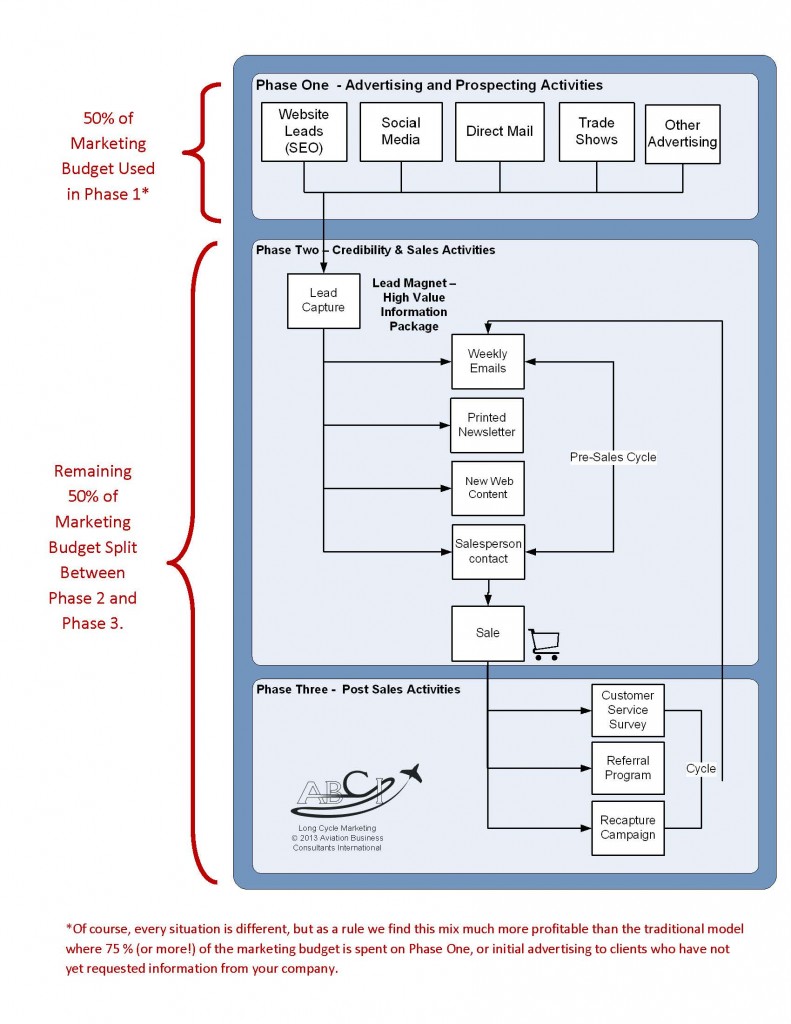“Why do we lose money on advertising? Why don’t I see a return on investment for marketing?”
An aviation company executive, on the phone with us for the first time, was clearly exasperated.
He had spent thousands on a magazine ad, thousands more on an email campaign, and had yet to recoup his “losses.”
“If advertising is an investment, where the heck is the ROI?” he complained.
I absolutely understand his frustration.
Advertising for new customers is an expensive proposition. Trade shows, magazine ads, direct mail, even email broadcasts take good money out of your budget that you won’t see again for awhile. If you have an incomplete marketing system (or a “leak,” or malfunctioning piece your marketing system) most likely you’ll never see that money again.
No matter how good an advertising campaign is, everything else in your marketing system has to support it. Your ad should have a call to action that leads people (that see the ad) to your website or to call a phone number. If your website doesn’t provide a good impression in the first few seconds, or if the person answering the phone is not an effective salesperson, most prospects won’t continue. There are lots of options on the market these days and decision makers are reluctant to part with their capital.
Even if you DO make a great impression, chances are it will be weeks or months before the sale is consummated. Unless you have a great information delivery or “lead nurturing” system in place, chances are they’ll forget about your fantastic ad and the fantastic conversation they had with you before the “stars line up” for the transaction – and they’ll either get talked out of buying your product or will spend the money elsewhere.
It IS possible to achieve a positive ROI on marketing, but it takes a complete marketing system that protects your investment AFTER each advertisement.
A realistic ROI also needs to be calculated based on the cost to acquire a customer, the length of your sales cycle, and more importantly, the lifetime value of a customer. In the aviation industry in particular, all of these figures are probably higher than you think. But it’s vitally important to know each of these numbers.
As a result of years of practice in the aviation industry in the trenches, we’ve developed Long Cycle Marketing to protect ours (and our clients’) investments. It’s designed to reduce the initial cost to acquire customers. It can shorten the sales cycle where possible by delivering high-quality information using appropriate, sometimes automated methods. Where the sales cycle can’t be shortened, Long Cycle Marketing ensures that leads continue to be nurtured cost effectively. Most importantly, we remain in contact with current and past customers, who are your very best source of referrals, testimonials, and repeat purchases.
While most marketing companies focus on Phase One, we recommend spending only 50% of your marketing budget on Phase One Activities, and dividing the remaining 50% between Phase Two and Phase Three (depending on the amount of time your company has been in business and the number of customers you’ve served in the past, among other factors.)
Phase One is a necessary part of growing your company; therefore we recommend a mix of media in order to establish credibility and reach new customers. However, advertising to people you have no prior connection with is the least cost-effective form of marketing. Advertising experts acknowledge that marketing initiatives having to do with new customer acquisition frequently don’t even achieve 100% return on investment (ROI.)
Phase one activities . . .” incur negatives; an expense, or more properly thought of,
investment in securing a customer, just as digging an oil well requires investment before any oil can be withdrawn for profit.”
– Dan Kennedy, GKIC Insider’s Circle Marketing Letter, June 2013.
Phase Two activities occur once a prospective customer has taken some action, such as downloading an ebook or requesting an information package. These prospective customers have a much higher probability of engaging your services, and are a much better “bet” for marketing investments. We recommend developing high-quality materials to keep these prospects engaged during the time between first contact and the consummated transaction.
Your best return on investment will come from Phase Three activities. Customers who already know, like and trust you are far less expensive to “re-acquire” than new customers who have never heard of you. This is also your best source of marketing materials, since what customers say about us is much more trusted than anything we can say about ourselves.







Leave A Comment